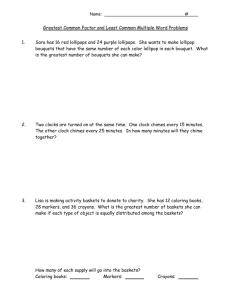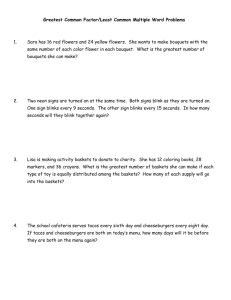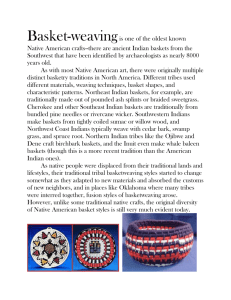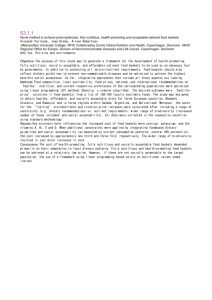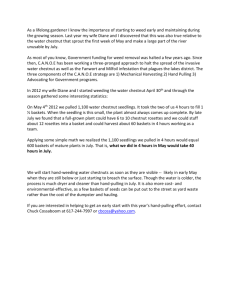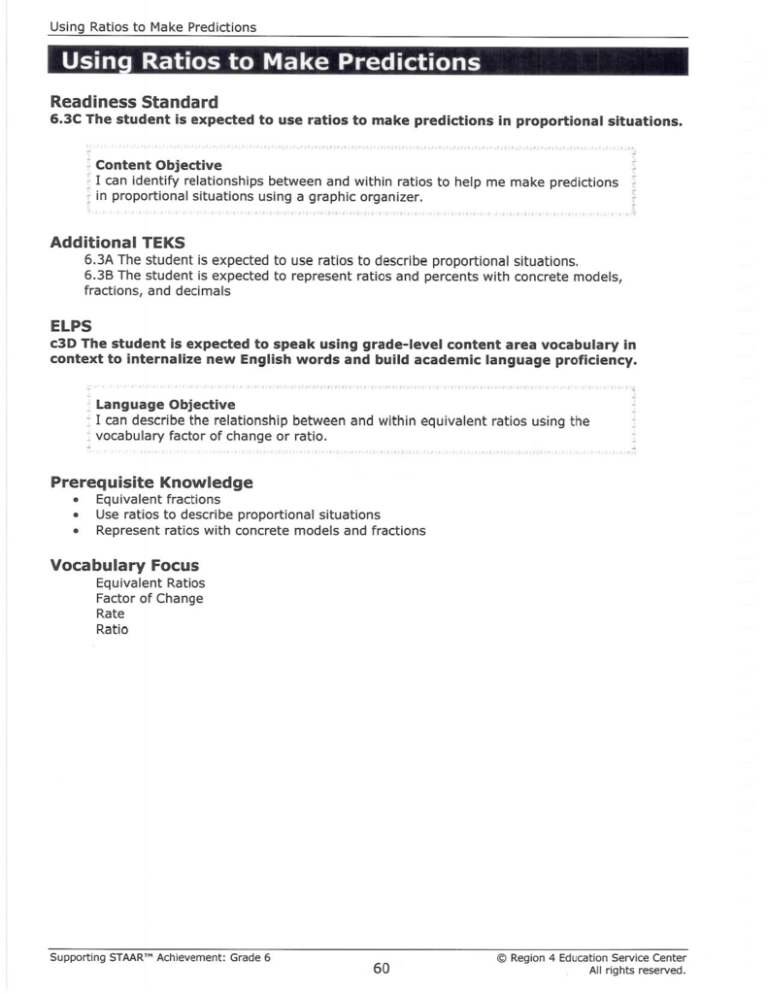
Name: _________________________________
Using Ratios to Make Predictions
Friendship Bracelets
Yvette was making friendship bracelets for her 4 friends. On each bracelet, she put
3 orange beads and 4 green beads. Yvette used a table to organize her information.
Help Yvette complete the table below to determine how many orange and how many
green beads she will need to make all 4 bracelets. Use centimeter cubes to model the bracelets.
Number of
Bracelets
1
Number of
Orange Beads
3
2
Number of Green
Beads
Representing the Ratio
of Orange to Green
Beads
4
8
Picture
o
o
o
o
o
o
g
g
g
g
g
g
g
g
2 groups of 3
orange beads to
4 green beads
with
words
with
fraction
bar
with
colon
3
6
8
3:4
How many total orange and green beads will Yvette need for her 4 friends?
Orange Beads_____
Green Beads____
© Region 4 Education Service Center
All rights reserved.
Supporting STAAR™ Achievement: Grade 6
Using Ratios to Make Predictions
Four Corners
Directions
1. Read the problem.
2. Work silently to determine your answer.
3. When instructed, stand by your answer posted in one of the four
corners of the room.
4. When you arrive at your corner, find a partner.
5. Use the following two prompts when discussing your answer:
• I believe this ratio accurately compares . . .
• I believe this ratio represents a part-to-part relationship or
part-to-whole relationship because . . .
Problem 1
At Ramos Middle School, 10 out of every 14 students take the bus to
school. Which ratio accurately compares the number of students who
take the bus to school to the number of students who do not take the
bus to school?
Problem 2
At Ramos Middle School, 10 out of every 14 students take the bus to
school. Which ratio accurately compares the number of students who
do not take the bus to school to the number of students who do take
the bus to school?
Problem 3
Mrs. Hagger has 24 students in her class. Fourteen of her students
take the bus to school. The rest of her students do not take the bus to
school. Which ratio accurately compares the number of students who
take the bus to school to the number of students who do not take the
bus to school?
Problem 4
Mrs. Wilson has 21 students in her class. Six of her students take the
bus to school. The rest of her students do not take the bus to school.
Which ratio accurately compares the number of students who do not
take the bus to school to the total number of students in Mrs. Wilson’s
class?
© Region 4 Education Service Center
All rights reserved.
Supporting STAAR™ Achievement: Grade 6
Using Ratios to Make Predictions
Four Corners*
Four Corners Answer Choices
5 to 2
2 to 5
7 to 5
5 to 7
Problem 1
At Ramos Middle School, 10 out of every 14 students take the bus to
school. Which ratio accurately compares the number of students who
take the bus to school to the number of students who do not take the
bus to school?
Problem 2
At Ramos Middle School, 10 out of every 14 students take the bus to
school. Which ratio accurately compares the number of students who
do not take the bus to school to the number of students who do take
the bus to school?
Problem 3
Mrs. Hagger has 24 students in her class. Fourteen of her students
take the bus to school. The rest of her students do not take the bus to
school. Which ratio accurately compares the number of students who
take the bus to school to the number of students who do not take the
bus to school?
Problem 4
Mrs. Wilson has 21 students in her class. Six of her students take the
bus to school. The rest of her students do not take the bus to school.
Which ratio accurately compares the number of students who do not
take the bus to school to the total number of students in Mrs. Wilson’s
class?
© Region 4 Education Service Center
All rights reserved.
Supporting STAAR™ Achievement: Grade 6
Using Ratios to Make Predictions
Four Corners Cards
Cut along the dotted lines.
5 to 2
2 to 5
7 to 5
5 to 7
© Region 4 Education Service Center
All rights reserved.
Supporting STAAR™ Achievement: Grade 6
Name: _________________________________
Using Ratios to Make Predictions
Bucketball
Use the data in the Bucketball Recording Sheet to answer the questions below.
Part I (My Data)
1. How many baskets did you make in 30 seconds?
2. How did your prediction compare to the actual number of baskets you made in 30 seconds.
3. If you continued to make baskets at this same rate, complete the table to show the number of
baskets for different lengths of time.
Time in Minutes
1
2
3
5
10
30
Number of Baskets
a. Describe any patterns or relationships you see in the table.
b. How many baskets could you make in 1 hour at this same rate?
4. If you continued to make baskets at this rate, complete the table to show the number of
baskets for different lengths of time.
Time in Hours
1
2
3
5
Number of Baskets
a. Describe any patterns or relationships you see in the table.
b. At this same rate, how many baskets would you make in 1.5 hours? 2.5 hours?
c. Explain how you determined your answer.
d. Do you think you would be able to continue to make baskets at this same rate each hour?
Why or why not? Explain your reasoning.
© Region 4 Education Service Center
All rights reserved.
Supporting STAAR™ Achievement: Grade 6
Using Ratios to Make Predictions
Part II (Group Data)
1. Combine your group’s data from Problem 1 on Part 1 to fill in the table.
The Sum of the Number of Seconds
The Sum of the Number of Baskets
2. If your team continued to make baskets at this same rate, complete the table to show the
number of baskets for different lengths of time.
Time in Minutes
2
3
4
10
30
Number of Baskets
a. Describe any patterns or relationships you see in the table.
b. How many baskets would your team make in 1 hour at this same rate?
3. If your team continued to make baskets at this same rate, complete the table to show the
number of baskets for different lengths of time.
Time in Hours
1
2
3
4
Number of Baskets
a. Describe any patterns or relationships you see in the table.
b. At this same rate, how many baskets would your team make in 1.5 hours? 2.5 hours?
c. Explain how you determined your answer.
d. Do you think your team would be able to make baskets at this same rate each hour? Why or
why not? Explain your reasoning.
© Region 4 Education Service Center
All rights reserved.
Supporting STAAR™ Achievement: Grade 6
Using Ratios to Make Predictions
Bucketball Recording Sheet
Cut along the dotted lines. Four sets of recording sheets are provided.
Bucketball Recording Sheet
Team Members
Predicted Number of Baskets
Actual Number of Baskets
in 30 seconds
Bucketball Recording Sheet
Team Members
Predicted Number of Baskets
Actual Number of Baskets
in 30 seconds
Bucketball Recording Sheet
Team Members
Predicted Number of Baskets
Actual Number of Baskets
in 30 seconds
Bucketball Recording Sheet
Team Members
Predicted Number of Baskets
Actual Number of Baskets
in 30 seconds
© Region 4 Education Service Center
All rights reserved.
Supporting STAAR™ Achievement: Grade 6
Using Ratios to Make Predictions
Bucketball Instructions
Set Up
1. Place a marker 5 feet from your team bucket.
2. Place approximately 25 bucketballs next to the marker.
3. Determine the team member(s) who will be in charge of keeping
track of the time.
Collecting Data Instructions
1. Record the names of each team member on the Bucketball
Recording Sheet.
2. Predict and record how many baskets you think each team
member will make in 30 seconds.
3. One person at a time will make as many baskets as possible
within 30 seconds. All other team members should be either
keeping track of the time or counting the number of baskets their
team member makes.
4. Each person will record his or her data on the Bucketball
Recording Sheet.
5. Return to your seats and complete Bucketball.
I have
the stop
watch.
Marker
We are
counting
the
number of
baskets.
© Region 4 Education Service Center
All rights reserved.
Supporting STAAR™ Achievement: Grade 6
© Region 4 Education Service Center
All rights reserved.
Problem 2
Problem 1
___basket
___baskets
___min
___min
=
___baskets
=
___min
___baskets
___min
=
=
___baskets
___min
___baskets
___min
Problem 2
Sometimes simplifying a ratio first can help us
work with friendlier numbers.
Problem 1
___baskets
___min
___basket
___min
Using Ratios to Make Predictions
Using Ratios to Make Predictions Notes Page
Cut along the dotted lines. Fold along the bold line.
Supporting STAAR™ Achievement: Grade 6
© Region 4 Education Service Center
All rights reserved.
Between
What relationship do you see
between the ratios?
What relationship do you see
within each ratio?
Number of
Baskets
Time in
Minutes
Within
Number of
Baskets
Time in
Minutes
Using Ratios to Make Predictions
Supporting STAAR™ Achievement: Grade 6
Using Ratios to Make Predictions
Ratios and Relationships
Solve each problem in two different ways.
• Use the relationship within each ratio to make a prediction.
• Use the relationship between the ratios to make a prediction.
Problem 1
Lisa’s group was responsible for decorating the football team’s
school lockers for homecoming. The group was able to decorate
12 lockers in 60 minutes. If they continue decorating at this rate,
how many lockers could be decorated in 3 hours?
Problem 2
A radio program advertises that 3 out of every 24 callers will receive
a prize. Based on this information, how many callers out of
120 callers should receive a prize?
© Region 4 Education Service Center
All rights reserved.
Supporting STAAR™ Achievement: Grade 6
Name: _________________________________
Using Ratios to Make Predictions
Ratios Circuit Recording Sheet
1. Cut out Ratios Circuit Cards and glue one card into the first box.
2. Solve the bottom half of the card. Show all your work, circle the method you used to solve the
problem, and record your answer.
3. The answer to the problem on the first card will be found on the top half of another card. The
answer to your first card will be your second card.
4. Glue the second card in the box labeled Second Card.
5. Continue until all cards have been worked in order.
Card
Work
Solution
First Card
Circle the relationship you
used to determine your
solution.
Within
or
Between
Second Card
Circle the relationship you
used to determine your
solution.
Within
Third Card
Between
Circle the relationship you
used to determine your
solution.
Within
© Region 4 Education Service Center
All rights reserved.
or
or
Between
Supporting STAAR™ Achievement: Grade 6
Using Ratios to Make Predictions
Card
Work
Solution
Fourth Card
Circle the relationship you
used to determine your
solution.
Within
or
Between
Fifth Card
Circle the relationship you
used to determine your
solution.
Within
or
Between
Sixth Card
Circle the relationship you
used to determine your
solution.
Within
or
Between
Seventh Card
Circle the relationship you
used to determine your
solution.
Within
© Region 4 Education Service Center
All rights reserved.
or
Between
Supporting STAAR™ Achievement: Grade 6
Using Ratios to Make Predictions
Ratios Circuit Cards
Cut along the dotted lines.
160
A map has a scale of 1 cm: 8 km. If two
cities are 11 centimeters apart on the
map, how many kilometers apart are
they?
115
A 6-ounce can of tomato sauce costs
$0.50. About how much will a 24-ounce
can of tomato sauce cost if the price per
ounce remains the same?
2
A survey at Jenkins Elementary indicated
that 9 out of 27 students take a lunch to
school every day. If 480 students attend
the school, about how many students can
be expected to bring their lunch every
day?
180
The team sold 14 lemonades in
90 minutes. If they continued selling
lemonades at this rate, how many
lemonades would they sell in 3 hours?
88
At the ice cream parlor, 4 chocolate ice
cream cones are sold for every 1 vanilla
ice cream cone sold. If 30 ice cream cones
are sold, how many do you expect to be
vanilla?
28
The ratio of pink rose bushes to white rose
bushes in a city garden is about 12 to 15.
If there are 92 pink rose bushes, about
how many white rose bushes would there
be?
6
Jumping rope burns approximately
720 calories per hour. If Jenny jumps rope
for 15 minutes, about how many calories
will she burn at this same rate?
© Region 4 Education Service Center
All rights reserved.
Supporting STAAR™ Achievement: Grade 6
Using Ratios to Make Predictions
Ratios Circuit Hint Cards*
Cut along the dotted lines. Fold along the solid line before attaching.
160
A map has a scale of 1 cm: 8 km. If two
cities are 11 centimeters apart on the
map, how many kilometers apart are
they?
Hint
What is the relationship within the given
ratio?
How can you use this relationship to
determine how many kilometers apart the
two cities are?
Hint
115
A 6-ounce can of tomato sauce costs
$0.50. About how much will a 24-ounce
can of tomato sauce cost if the price per
ounce remains the same?
What is the relationship between the
ounces of each can?
How can you use this relationship to
determine the approximate cost of the
larger can?
Hint
2
A survey at Jenkins Elementary indicated
that 9 out of 27 students take a lunch to
school every day. If 480 students attend
the school, about how many students can
be expected to bring their lunch every
day?
© Region 4 Education Service Center
All rights reserved.
Simplifying the given ratio may help you
see the relationship.
Supporting STAAR™ Achievement: Grade 6
Using Ratios to Make Predictions
Hint
6
Jumping rope burns approximately
720 calories per hour. If Jenny jumps rope
for 15 minutes, about how many calories
will she burn at this same rate?
How many minutes are in 1 hour?
Simplifying the given ratio may help you
see the relationship.
Hint
180
How many minutes are in 3 hours?
The team sold 14 lemonades in
90 minutes. If they continued selling
lemonades at this rate, how many
lemonades would they sell in 3 hours?
Hint
88
At the ice cream parlor, 4 chocolate ice
cream cones are sold for every 1 vanilla
ice cream cone sold. If 30 ice cream cones
are sold, how many do you expect to be
vanilla?
Is the question asking for a part-to-part
comparison or a part-to-whole
comparison?
What would the initial ratio be in this
problem?
Hint
28
The ratio of pink rose bushes to white rose
bushes in a city garden is about 12 to 15.
If there are 92 pink rose bushes, about
how many white rose bushes would there
be?
© Region 4 Education Service Center
All rights reserved.
Simplifying the given ratio may help you
see the relationship.
How could you use this relationship to
help you determine how many white rose
bushes there are?
Will there by more pink or white rose
bushes? How do you know?
Supporting STAAR™ Achievement: Grade 6
Name: _________________________________
Using Ratios to Make Predictions
Evaluate: Using Ratios to Make Predictions
1. Alex has baseball practice for 6 hours and swimming practice for 7 hours each week. If Alex
continues to practice these sports at this rate, about how many total hours will he have
practiced in 8 weeks?
Record your answer and fill in the bubbles. Be sure to use the correct place value.
2. Five teachers are competing to see who can sell the most raffle tickets at the school carnival.
The table shows how many raffle tickets each teacher sold for the given time period.
Teacher’s Name
Time in Minutes
Number of Raffle
Tickets
Mr. Salinas
10
4
Ms. Ray
15
5
Mr. Griffin
20
9
Ms. Heard
30
12
If each teacher’s rate remains the same, who will have sold the most tickets after 1 hour?
A
Mr. Salinas
B
Ms. Ray
C
Mr. Griffin
D Ms. Heard
© Region 4 Education Service Center
All rights reserved.
Supporting STAAR™ Achievement: Grade 6
Using Ratios to Make Predictions
3. Two 18-pound dogs eat 3 pounds of dog food each week. About how many pounds of dog
food would be needed to feed six 18-pound dogs if they ate the same amount per week?
A
2 pounds
B
6 pounds
C
8 pounds
D 9 pounds
4. If there are 25 students in Mrs. Ebstein’s class and the ratio of boys to girls is 2 to 3, how
many boys and how many girls are in Mrs. Ebstein’s class?
A
10 boys, 15 girls
B
15 boys, 10 girls
C
16 boys, 9 girls
D
9 boys, 16 boys
© Region 4 Education Service Center
All rights reserved.
Supporting STAAR™ Achievement: Grade 6

